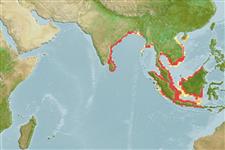分类 / Names
俗名 | 同种异名 | Catalog of Fishes(属, 种) | ITIS | CoL | WoRMS | Cloffa
Teleostei >
Carangaria/misc (Various families in series Carangaria) >
Polynemidae (Threadfins)
Etymology: Filimanus: Latin, filum = thread + latin, manus = hand (Ref. 45335); xanthonema: From the Greek word 'xantho' yellow, and 'nema', thread, in reference to yellow pectoral filaments (Ref. 39607).
More on author: Valenciennes.
Environment: milieu / climate zone / depth range / distribution range
生态学
海洋 居于水底的; 深度上下限 1 - 30 m (Ref. 57343). 热带; 25°N - 9°S, 79°E - 117°E (Ref. 57343)
Indo-West Pacific: east coast of India to Lombok, Indonesia.
印度-西太平洋: 对 Lombok ,印度尼西亚的印度东海岸。
大小 / 重量 / 年龄
Maturity: Lm ? range ? - ? cm
Max length : 14.0 cm SL 雄鱼/尚未辨别雌雄; (Ref. 57343)
背的软条 (总数) : 11 - 13; 臀鳍软条: 10 - 12. Distinguished by having six (occasionally five or seven) pectoral filaments, not reaching midpoint of anal fin; depth of posterior margin of maxilla less than eye diameter; snout pointed; and body in life usually dusky yellow or green above and silvery below.
区别的特徵为有六 (偶然地五或七)个胸的丝状突起, 不达到臀鳍的中点; 颚骨的后缘的深度少于眼直径; 吻尖的; 而且身体活着时通常暗黄色或绿色的上方与下面银色的。
Inhabits muddy bottoms (Ref. 57343). Feeds on small crustaceans (Ref. 57343). Protandric species (Ref. 57343).
栖息于泥底部。 (参考文献 57343) 吃小型甲壳动物。 (参考文献 57343) 雄性先熟的种.(参考文献 57343)
Life cycle and mating behavior
Maturities | 繁殖 | Spawnings | Egg(s) | Fecundities | 仔鱼
印度-西太平洋: 对 Lombok ,印度尼西亚的印度东海岸。
Motomura, H., 2004. Threadfins of the world (Family Polynemidae). An annotated and illustrated catalogue of polynemid species known to date. FAO Spec. Cat. Fish. Purp. Rome: FAO. 3:117 p. (Ref. 57343)
人类利用
渔业: 没有兴趣
工具
特别资料
下载 XML
网络资源
Estimates based on models
Preferred temperature (Ref.
123201): 28 - 29.4, mean 28.9 °C (based on 616 cells).
Phylogenetic diversity index (Ref.
82804): PD
50 = 0.5156 [Uniqueness, from 0.5 = low to 2.0 = high].
Bayesian length-weight: a=0.00676 (0.00308 - 0.01483), b=3.10 (2.91 - 3.29), in cm total length, based on LWR estimates for this (Sub)family-body shape (Ref.
93245).
营养阶层 (Ref.
69278): 3.4 ±0.51 se; based on food items.
回复力 (Ref.
120179): 高度, 族群倍增时间少于 15个月 (Preliminary K or Fecundity.).
Fishing Vulnerability (Ref.
59153): Low vulnerability (10 of 100).
